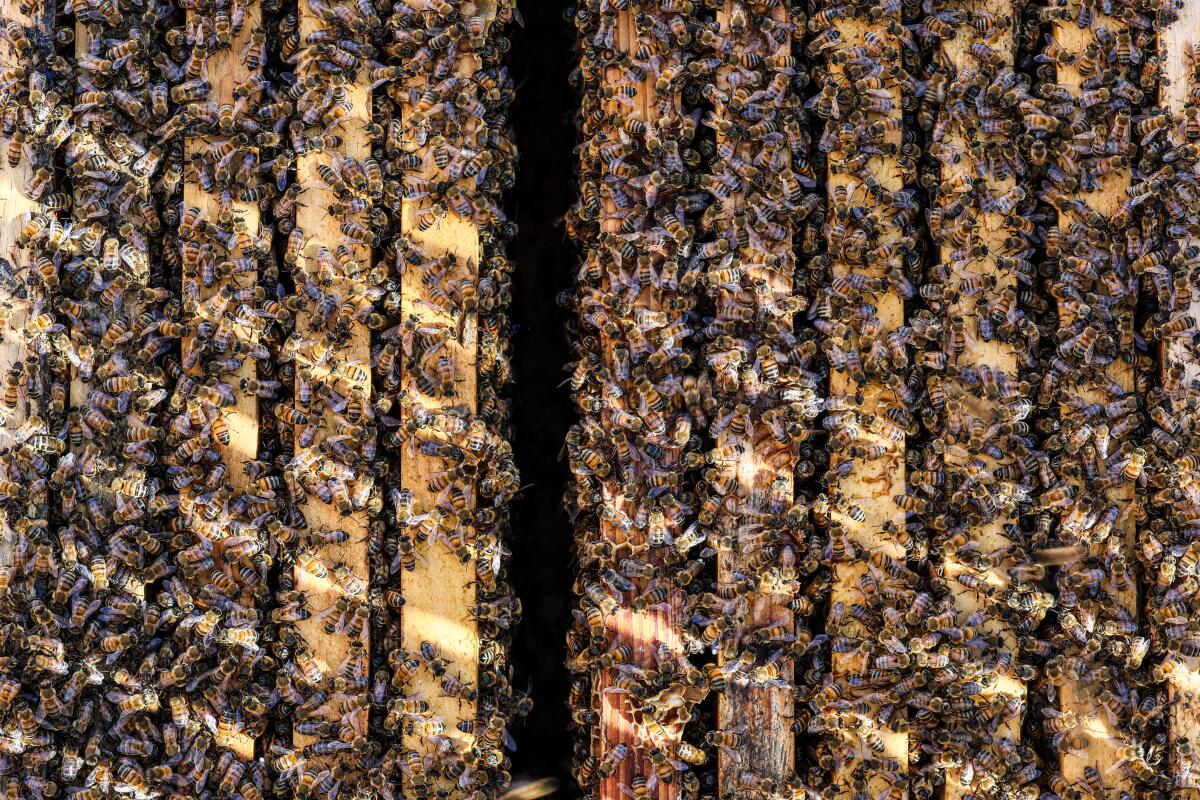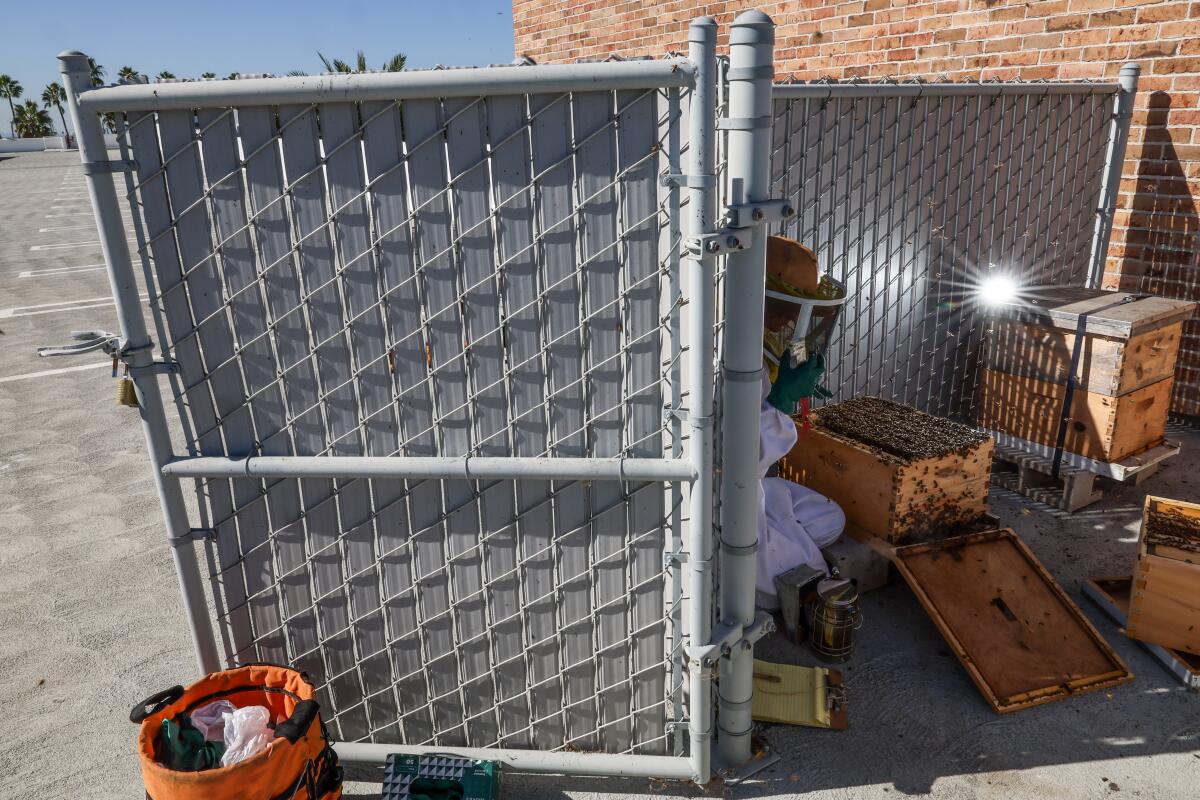
On an afternoon in late summer, the bees that live at a Long Beach mall were flying high, winging their way back to their hives atop a parking garage.
Upon their return, they emptied the “pollen pants” they were sporting on their hind legs to make food for the colony’s offspring. The colorful clusters of pollen are a sign of the bees are well and producing more honey than they need to eat.
“Your bees are healthy, happy and looking good,” the beekeeper’s monthly report to the mall’s owner said. “We were able to make a hefty harvest from Hive 2.”

Far from happenstance, the arrival of the bees at 2nd & PCH came at the invitation of CenterCal Properties, which owns the outdoor mall. Treated like valued — albeit nonpaying — tenants running a business, not interlopers to be shooed away, their presence reflects a growing trend among owners of shopping centers and other commercial buildings such as offices looking to set their properties apart from the competition and underscore their commitment to improving the environment. In addition to making honey to share with shoppers, the bees also provide research data points used to help prevent die-offs.
To make their jobs easier, CenterCal Properties has landscaped it with hanging baskets, gardens and planters raising fragrant native plants that bees find appealing, such as Spanish lavender, Tuscan blue rosemary and yarrow. The bees also travel miles away in their search for nectar, which they collect in their stomachs and bring back to make honey.
The bees, which are bred to be docile, do little to make their presence known, said Samantha Lopez, general manager of the upscale $100-million mall on Pacific Coast Highway overlooking Alamitos Bay. On a recent afternoon, as ocean breezes cooled the mall, not a bee was in sight as visitors strolled past bee-friendly flora on their way to such stores as Johnny Was and Anthropologie, or relaxed among greenery-filled planters and pots outside Shake Shack and Whole Foods Market.
“Nobody has noticed anything,” Lopez said, “and we don’t call attention to the hives themselves.” The hives are short stacks of wooden boxes sheltered behind a covered cyclone fence.
CenterCal has replicated its bee experiment at other shopping centers that the El Segundo-based retail property developer owns in Oregon and Utah. Colonies are also planned at other company malls.
“The goal is to keep expanding,” Lopez said, perhaps including another hive at 2nd & PCH to help meet her target of harvesting 20 pounds of honey per year. She’ll know by the end of December whether she needs a third hive.

The bees’ presence and the honey they make help promote 2nd & PCH at a time when owners labor to create memorable identities for their malls and offer experiences shoppers can’t get when they buy online.
In August, the shopping center celebrated World Honey Bee Day with a kid-oriented party that included a “pollinator scavenger hunt” to find bee-inspired fun facts hidden among storefronts. Prizes were products produced from the center’s hives, including small jars of honey, honey-based lip balm and seed packs for native California plants. A contest to name the queen of each hive is coming up.
The honey that Lopez shares with mall tenants and shoppers tastes different from honey made at CenterCal malls near Portland, Ore., and Salt Lake City because the bees are collecting pollen and nectar from different kinds of local flowers in each location.
“Honey is just flower juice,” said Noah Wilson-Rich, founder of Best Bees, which provides beekeeping services to corporate clients such as CenterCal.
Although Wilson-Rich acknowledges a weakness for the intense flavor and molasses-like consistency of dark honey made from the nectar of avocado tree flowers, bees that live on the nectar of wildflowers live longer and make more honey.
Best Bees conducts DNA tests on honey to identify which wildflowers a client’s bees are sweet on and provides them with suggestions of what to plant. The regional variations in the honey their bees produce give CenterCal the chance to hold tasting competitions among its honey-producing properties. Taste variations also offer an incentive to spread bee hives among corporate properties around the country, Wilson-Rich said.
Investors commonly track the environmental sustainability of their holdings as a measure of their desirability, and commercial property landlords typically incorporate ESG initiatives — environmental, social and governance — into their properties. Bees are an easy win on both fronts as executives tend to find bees more charismatic than, say, carbon reduction programs and wastewater management.

Real estate companies with properties in many cities can “taste the impact” of their bee initiatives, Wilson-Rich said. “I know it sounds a little corny, but at investor meetings, we can have honey from each property and explain the different tastes in honey by location.”
Local regulations forbid international real estate company Kennedy Wilson from putting hives at its headquarters in Beverly Hills, but they’ve been a welcome presence at an office building the firm owns in Westlake Village, said the company’s ESG head, Alex Spilger.
Honey from the four hives at One Westlake near the 101 Freeway changes in taste and color from season to season as the bees hunt for nectar over 12 square miles, he said.
“It’s an important part of the social component of our ESG program,” Spilger said of the bee program managed by Best Bees. “It benefits the surrounding community and provides the bees a home to pollinate local vegetation and and produce honey for our tenants and our stakeholders.”
Bee colonies are bellwethers of ecological health in the broadest sense, providing data that can be used to study climate change, enhance food security and mitigate natural disasters, Wilson-Rich said.
He started Best Bees as a business in 2010 to help study bee die-offs that were alarming scientists like him. Wilson-Rich has a doctorate in biology from Tufts University and tracks hive health as part of the nonprofit research project Urban Bee Lab.
Its goal is to stabilize honeybee health and then extend successful approaches to other, lesser-studied species of pollinators such as butterflies and bumblebees to promote biodiversity at corporate, residential and government sites
“You keep the honey, we keep the data,” he tells clients. The bees at 2nd & PCH and One Westlake are nodes in a research network.
“We partner up with groups like NASA, so we can see with satellites where pollinators are thriving and where are they dying and … how to help them,” he said.
Not long ago, it was illegal to keep bees in Los Angeles because 19th century experts decided they were a threat to the region’s vast citrus industry.
In 1879, Los Angeles lawmakers banned beekeeping within city limits. According to Mark Vallianatos, who taught environmental policy at Occidental College, their rationale was badly misguided. Having noted the affinity between bees and fruit trees, they reasoned that bees attacked and damaged fruit, and concluded that outlawing bees was the best way to preserve crops, Wilson-Rich wrote in an op-ed column.

Soon scientists debunked the theory — bees are vitally important pollinators — and by 1917, The Times was calling the no-beekeeping policy “an ancient and still-unrepealed city ordinance.” Yet urban beekeeping remained illegal until 2015, when the City Council approved “backyard” or urban beekeeping.
Part of the delay was due to fear of people getting stung, but Wilson-Rich says bees with good breeding don’t cause that kind of trouble. If bees in a hive act prickly, a beekeeper can swap out their queen with a docile one and the hive will repopulate in a few weeks.
“Nice queens,” he said, “produce nice bees.”